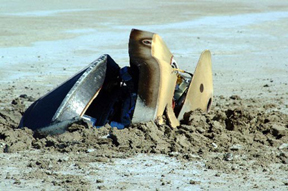 The
world watched last September as the spacecraft Genesis, launched in 1998, returned
to Earth with a crash-landing on Utah’s desert floor. The sample return
marks the beginning of a potentially long research effort to investigate the
composition of the sun and its implications for the solar system’s evolution.
The
world watched last September as the spacecraft Genesis, launched in 1998, returned
to Earth with a crash-landing on Utah’s desert floor. The sample return
marks the beginning of a potentially long research effort to investigate the
composition of the sun and its implications for the solar system’s evolution.
The Genesis capsule crashed to Earth in September, at the U.S. Army Proving Ground in Dugway, Utah, carrying samples from the sun. Researchers recovered pieces of the samples to send to the Johnson Space Center in Houston in October. Image courtesy of NASA/JPL.
On Sept. 8, stunt helicopters waited to snag the 1.5-meter-wide capsule once its parachutes released. But the parachutes never opened. Genesis landed on its side in the desert mud and cracked open. Although they feared contamination of the samples, scientists remained optimistic after the craft was recovered that day. They took a first look inside the capsule on Sept. 9, in a clean room at the U.S. Army Proving Ground in Dugway, Utah.
“The science team was most interested in a canister that held the solar wind collectors,” says Roger Wiens, a science co-investigator and instrument lead scientist from Los Alamos National Lab in New Mexico, who was present during several days of the preliminary investigations. These collectors are integral to the Genesis mission: understanding the isotopic compositions of oxygen, nitrogen and noble gases in the sun.
Larry Nittler of the Carnegie Institution of Washington, who is not on the Genesis team but has been waiting for the spacecraft’s payload to return for experiments, says that models of solar system formation and evolution are shaped by the sun’s isotopic compositions. These isotopes cannot be sampled directly but are carried in the solar wind, which is composed of hot energetic particles that escape from the outer layers of the sun’s corona. If the measurements of the captured solar wind match one of these models, then “we can understand the full distribution” of certain isotope ratios, Nittler says. That comparison would be useful in explaining, for example, the large variation in the abundance of oxygen isotopes between different types of meteorites and planets.
During the initial assessment, Wiens says, team members could see that “a fair number of collector materials” pertinent to the mission survived, with some completely intact. Several of the collector arrays that held “wafers” made of different materials that captured solar wind atoms were sandwiched together, he says. One gold-foil-covered collector remained almost whole, but other more fragile wafers were broken to varying degrees, Wiens says.
Another solar-particle collector called the solar-wind concentrator, which consisted of four pie-shaped pieces, fared better: Only one piece had broken, while the others remained whole. The concentrator device used high voltages to capture solar wind particles in a small area, “a little like a magnifying glass would concentrate light,” Wiens says, and the force of the impact drove solar wind atoms into the sample collector, away from the surface. “We were elated to get that back in good shape,” he says.
The damage is “annoying, but it’s not fatal,” says Kevin McKeegan, a cosmochemist at the University of California, Los Angeles, and a co-investigator on the mission. Sample preparation “may take a little longer, with regard to cleaning,” he says. Also, the misshapen sample collectors will make it physically more difficult to analyze their payload, as scientists will have to find ways to fit the odd shapes into their apparatuses. McKeegan and other researchers are still in the process of building machines that will be used to study the samples. “You don’t need that much sample,” Nittler says.
The easiest analyses may prove to be of noble gases, which are both nonreactive and relatively rare on Earth, making those samples less likely to be contaminated from exposure to Utah mud, McKeegan says. But what scientists want most — oxygen isotope ratios — “is hardest to get,” he says, because of possible contamination from their high concentrations on Earth.
Samples could be available within the next year, depending on how long it takes to clean them, McKeegan says. The materials will return to the “cleanest clean room in NASA,” Wiens says, at the Johnson Space Center in Houston, Texas, built specifically for Genesis’ assembly. Curators in Houston, where samples will be stored in the same facility that holds lunar samples, will have to find ways to remove dust and other contaminants from the collectors’ surfaces, without disturbing the atoms embedded below. Researchers will probably create mock samples to test whether the real ones have been contaminated without sacrificing them. “Their job has gotten a lot more difficult,” Wiens says.
But scientists agree that time is on their side. “One of the real strengths of a sample return mission,” McKeegan says, is that “you can basically perform the analyses with state-of-the-art technology that didn’t exist when the mission launched.” And despite the “spectacular crash” and initial reports of failure, “we know where the sample is,” he says.
In the meantime, NASA has convened a review panel to determine what went wrong with Genesis’ parachute release, and whether the mechanism will be of concern for Stardust, the next mission to return to Earth with samples from space after its encounter with a comet, in January 2006.
Naomi Lubick
Back to top

